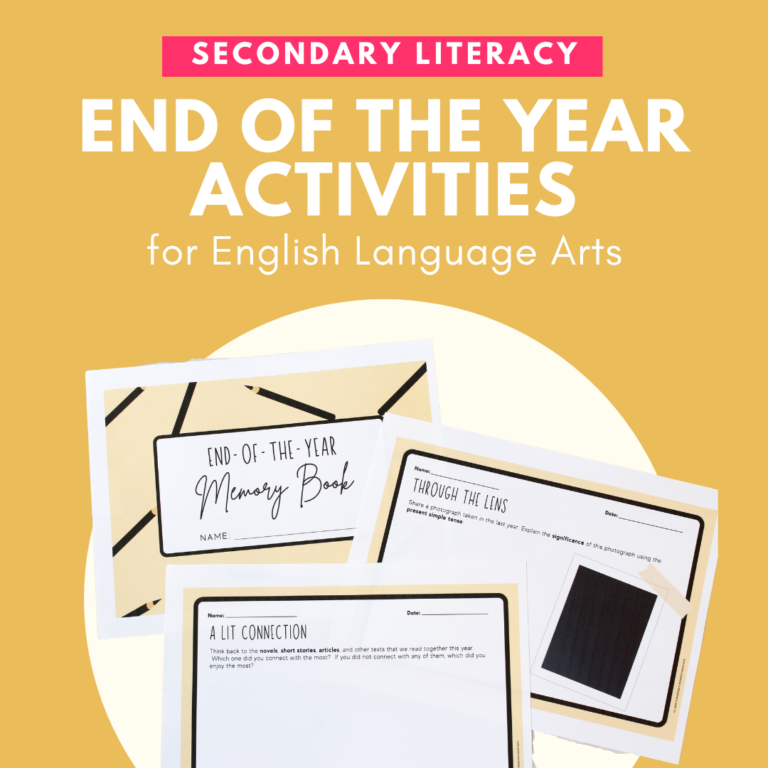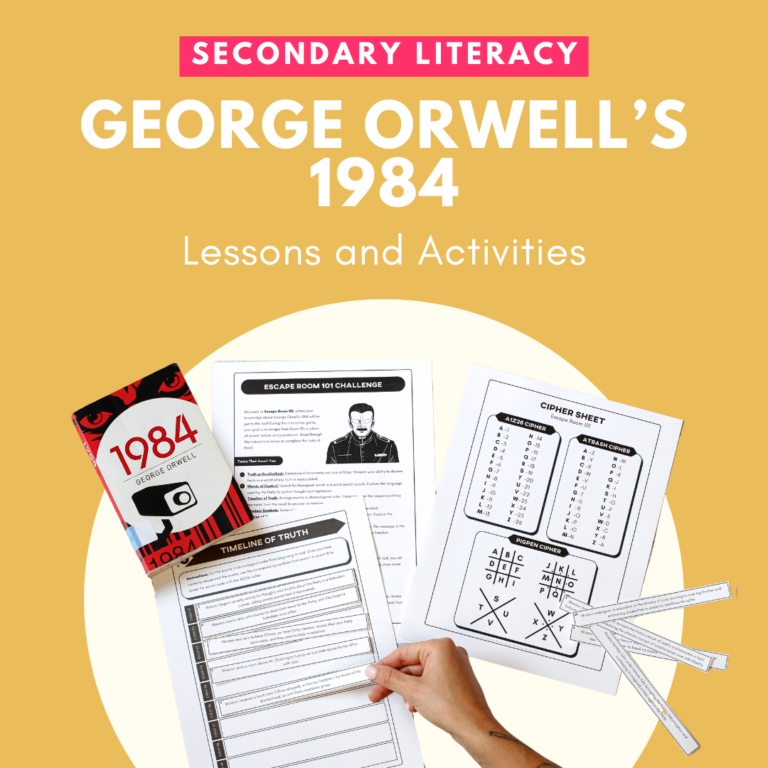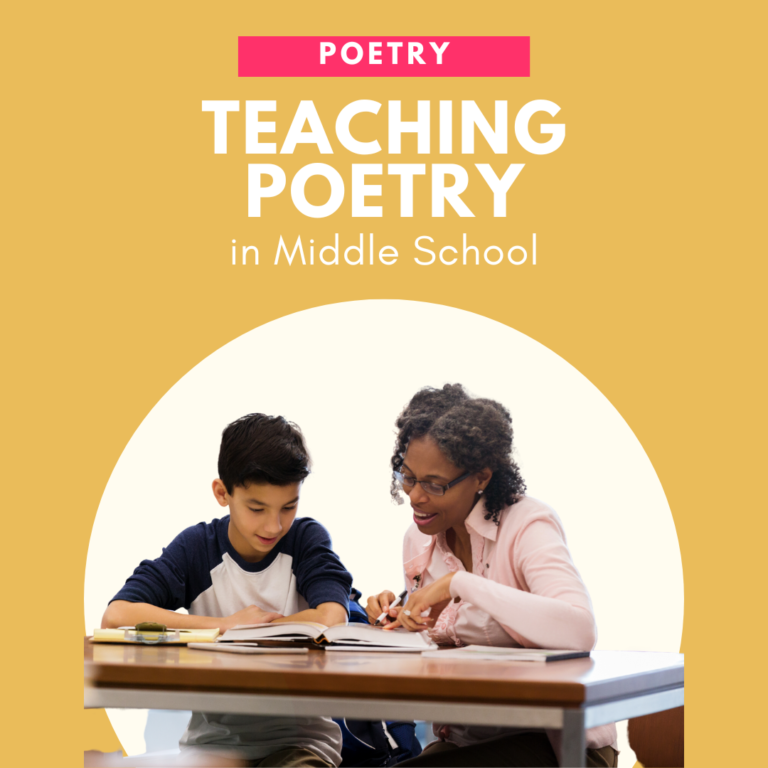One of the most rewarding parts of teaching high school poetry is the rich conversations you can have with students. No matter what school setting you teach in, your students likely have so much to say about poetry. When students feel confident in their abilities, they truly love the challenge of reading poetry. In this blog post, you will learn how you can foster a love for poetry in your students. You’ll also learn about activities and resources for teaching high school poetry.
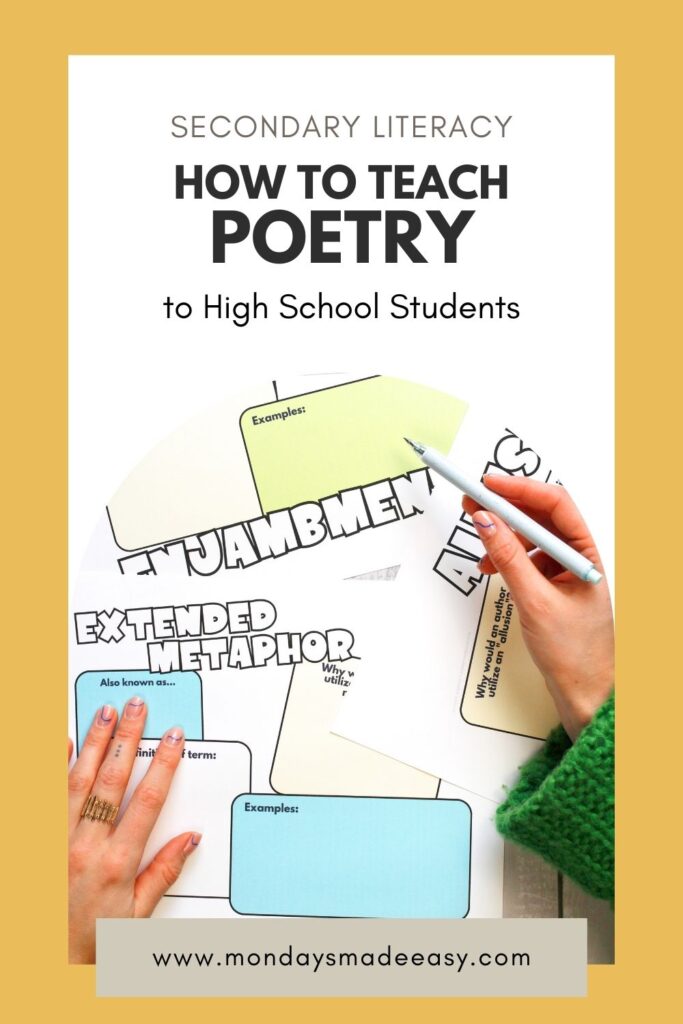
How Do You Introduce Poetry in High School?
Have your students ever described poetry as boring or confusing? It’s pretty common for teenagers to feel overwhelmed by poetry. This is because poetry is so different from the styles of writing that they are used to exploring in the classroom. In order for students to move past this attitude, they need to feel confident in their ability to read and interpret poetry.
To foster this level of confidence, it can be helpful to introduce poetry in high school at a slower pace. Before diving into a poem, you may want to first teach the basic elements of poetry. This will help students acquire and reinforce the necessary vocabulary to interpret poetry in the classroom.
Another way to set students up for success is to explore various poetic devices. Identifying literary devices in poetry allows students to explore deeper layers of meaning and develop more nuanced interpretations. Engaging in discussions about poetic devices also enhances their ability to analyze an author’s unique style and craft. Students can use this collaborative anchor chart activity to reinforce their understanding of literary devices in poetry.
A fun way to reinforce students’ understanding of literary devices is with this literary device matching game. Through game-based learning, students will match examples of various poetic devices to their correct terms. These game cards feature examples from both classic literature and modern pop culture to make learning both relevant and enjoyable for your students.
Activities to Teach High School Poetry
Exploring the Structure of a Poem
Teaching the elements of poetry is essential to any high school poetry unit. These elements include:
Stanza: A stanza is a group of lines within a poem, often following a specific pattern, meter, or theme – but not always. Stanzas are separated by breaks or blank lines, distinguishing them from other sections of the poem.
Meter: Meter refers to the rhythmic structure within a poem and is dictated by the number of syllables and the pattern in which these syllables are emphasized.
Rhyme: Rhyme occurs when the final syllable or syllables of different words sound alike. A poem is considered to rhyme when the last words of its lines share this pattern.
Scheme: A rhyme scheme is the pattern of rhyming words within a stanza of poetry. It may involve rhyming in every line, alternating lines, or forming couplets. Rhyme schemes are typically represented using a sequence of letters.
Verse: The verse of the poem is a way to describe the relationship between rhyme and meter in a poem.
We can interpret the elements of poetry as the “building blocks” of any poem. This elements of poetry lesson explores these elements through an interactive slideshow, gallery walk activity, and word wall anchor chart. By engaging with these activities, students will develop a strong foundational understanding of the structure of a poem.
Teaching Students How to Annotate Poetry
One of the most important skills for teaching poetry in high school is annotating. Annotating is the process of writing notes next to a verse of poetry. These notes may express thoughts, questions, evaluations, or definitions. They may also note the meter (or “rhythm”) of the poem. Annotating will help students develop an in-depth analysis of a poem.
Once students understand the elements of poetry and feel comfortable identifying poetic devices, they are ready to practice annotating. To teach annotation, you can break the process down into memorable steps for your students. This blog post shares a four-step process for annotating poetry.
An effective way to make annotation more accessible is by using song lyrics. Students already have a lot to say about their favourite artists and songs; because of the cultural relevance of the music they enjoy, it provides a familiar and compelling entry point for practicing annotation. By modelling this skill with lyrics, you can capture students’ interest while scaffolding their analytical abilities.
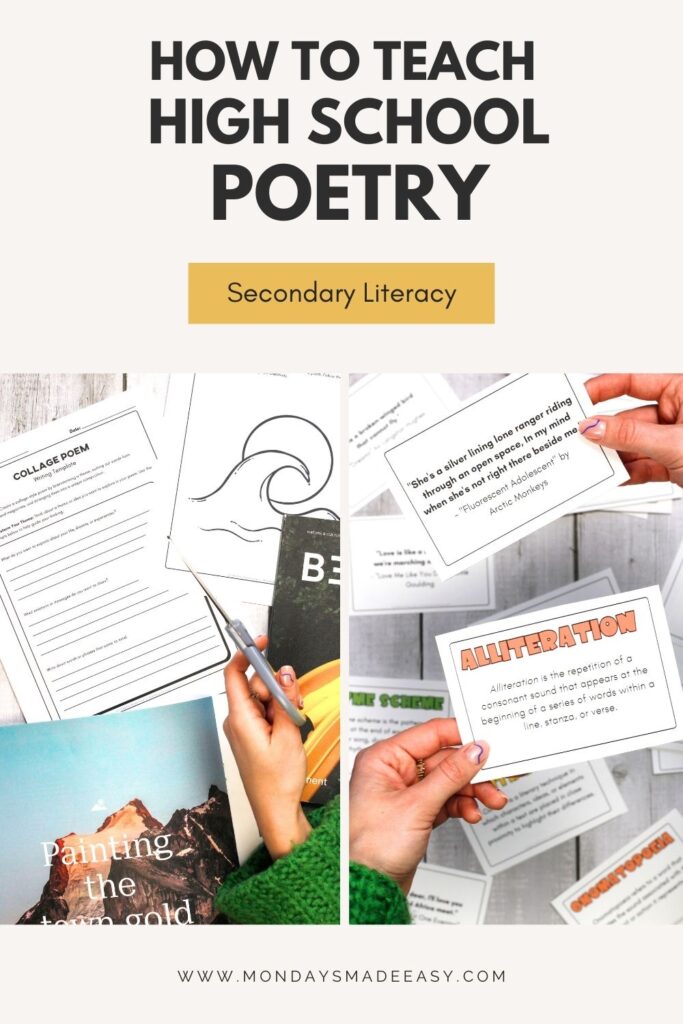
Poetry Unit for High School Students
This four-week poetry unit provides high school students with the tools they need to read and analyze poetry with confidence. Through slideshow lessons, interactive word wall activities, vocabulary anchor charts, bookmarks, and annotation exercises, students will build a strong foundation in poetic structure and interpretation.
How Do You Make Poetry Fun in High School?
If there’s any unit my high school students resonate with, it’s poetry! This is because there are so many ways to make poetry engaging and fun. For the most part, students enjoy poetry when they see its connection to popular culture. This is just one of the reasons that teaching poetry in high school is so rewarding.
To help students recognize the relevance of poetry, we explore a variety of modern poets across different forms. Many students are particularly drawn to the rise of free verse poets on Instagram, often called “Instapoets,” such as Rupi Kaur, Tyler Knott Gregson, and Kate Baer. Additionally, song lyrics provide a powerful connection between poetry and popular culture, making them an effective tool for teaching poetic devices.
Your students will likely find the most enjoyment in writing their own poetry. If they’re hesitant, you can start pff with icebreakers or creative writing prompts to encourage self-expression. Many students are drawn to the free verse styles popularized on Instagram, making a free verse poetry workshop a great way to spark their creativity.
If your students prefer more structured poetry, forms like sonnets, haiku, and limericks can be excellent choices. These styles help reinforce an understanding of rhythm and meter while also providing a window into the cultural and historical significance behind each form.
For high school seniors, odes offer a meaningful way to reflect on their accomplishments and experiences. With their celebratory nature, odes allow students to express pride, explore vivid imagery, and convey authentic emotions. This ode poetry writing workshop provides a powerful opportunity for self-expression as your students celebrate their high school journey.
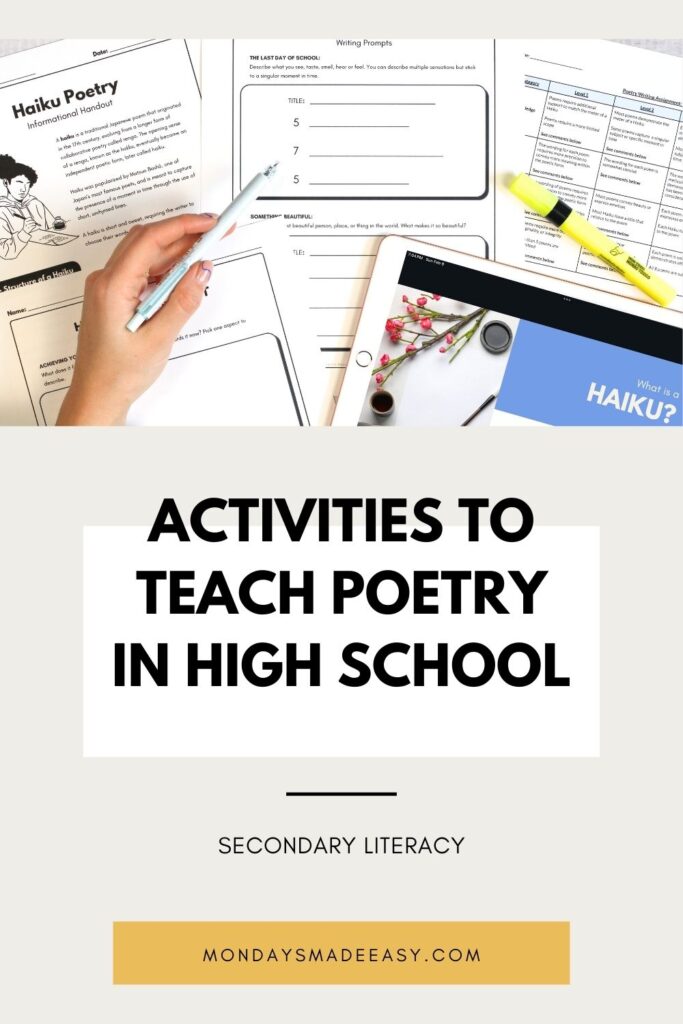
Best poetry for high school students
Here are a few poetry picks that your high school students will love!
Milk and Honey by Rupi Kaur – Kaur wrote this collection of poems at twenty-one. It shares her coming-of-age experience as an Indo-Canadian woman. It is vulnerable, feminine, powerful, and features simple illustrations alongside the text.
And Still I Rise by Maya Angelou – Angelou’s collection of poetry explores themes of strength, loneliness, and determination. The singular poem by the same name serves as a great read for an individual lesson.
“The Negro Speaks of Rivers” by Langston Hughes – This poem serves as a great lesson for exploring figurative language. This annotation lesson facilitates a guided close reading of the poem to teach your students how to annotate.
William Shakespeare’s Sonnets – These poems are a great way to explore Shakespeare’s iconic sonnet form. Students can read one of Shakespeare’s popular sonnets before writing their own using this sonnet writing workshop.
Night Sky with Exit Wounds by Ocean Vuong – Vuong is a Vietnamese American poet who reflects on memories of grief and war in this full-length collection of poems. His work is a great example of contemporary poetry.
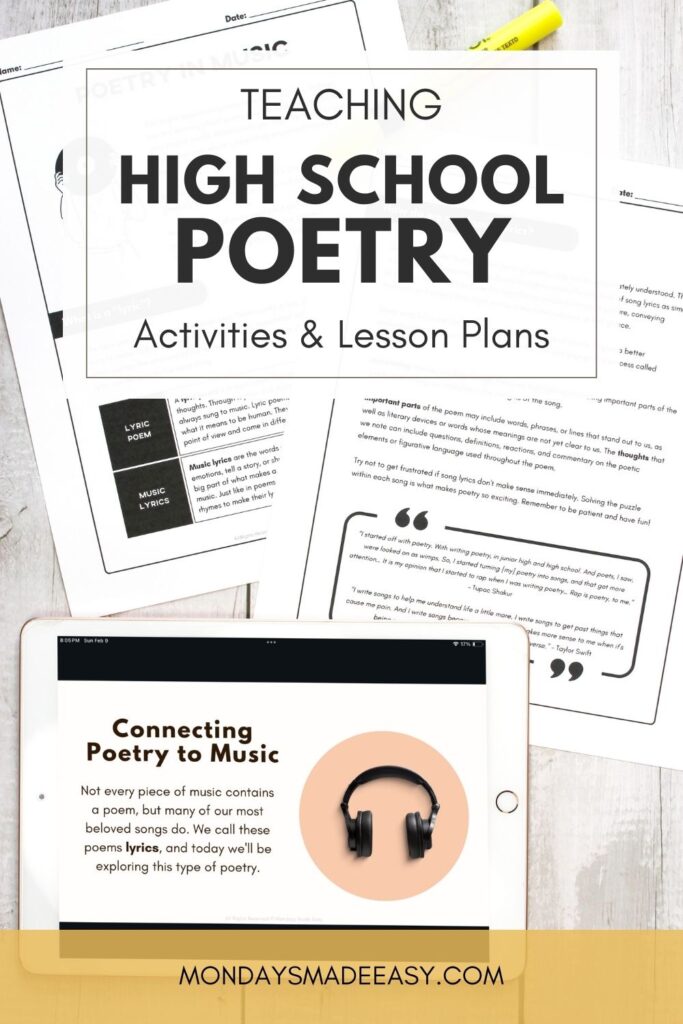
Teaching High School Poetry: Tying it All Together
There are so many ways to make poetry fun and engaging for high school students. I hope this blog post has helped you with a few lesson plans and activities to teach poetry in high school. It’s really inspiring to see students feeling confident in reading and analyzing poetry, and it makes for great classroom conversations!
To learn more about the lesson plans, writing workshops, and literary analysis activities featured in this blog post, check out this high school poetry unit.

